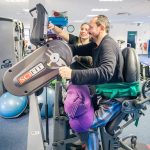Blog
Right to rehab: making neurological rehabilitation accessible to all
It was Christopher Reeve who sparked the idea of Neurokinex in the mind of Harvey Sihota, who sustained a spinal cord injury in 2009 after a freak fall. Here the chief executive of Neurokinex writes about how his curiosity has spearheaded new therapies for people with an SCI.
 When I sustained a T12 spinal cord injury in 2009 after a freak fall, I received excellent care from the NHS. But when I emerged from hospital three months later, I was faced by the prospect of my recovery being disrupted by a lack of community services.
When I sustained a T12 spinal cord injury in 2009 after a freak fall, I received excellent care from the NHS. But when I emerged from hospital three months later, I was faced by the prospect of my recovery being disrupted by a lack of community services.
After my discharge from the NHS spinal injuries rehabilitation centre at Stoke Mandeville, I avidly researched spinal cord injury. I learned about best practice and the latest innovations in therapies from around the world. Leading the way was the activity-based rehabilitation protocol, spearheaded in the US by the NeuroRecovery® Network and the Christopher & Dana Reeve Foundation.
Only a matter of time
Reeve’s belief that future technologies would bring us closer to a world without wheelchairs was compelling. He wasn’t daydreaming. His mission was backed by science and he knew it was only a matter of time before people with a spinal cord injury could expect far greater results from advances in rehabilitation and technology.
Now carrying his work and vision forwards, the NeuroRecovery® Network is determined to not only develop these groundbreaking protocols, but also to bring these within everyone’s reach.
This ethos resonated strongly within me and was my driving force behind setting up Neurokinex — a group of not-for-profit neurological rehabilitation centres that redefine possibilities for people living with a spinal cord injury. In 2013 we opened our first Neurokinex facility in Watford (now based in Hemel Hempstead). In 2015 we opened a centre in Bristol, followed by Gatwick in 2016, which was subsequently extended in 2018 to include a paediatric area so that children could benefit as adults do.
As well as building more physical sites, we strive to work with many different partners to ensure that everyone who needs us can benefit from our activity-based rehabilitation programme and world-leading protocols
As well as building more physical sites, we strive to work with many different partners to ensure that everyone who needs us can benefit from our activity-based rehabilitation programme and world-leading protocols.
Powerful partnerships
Partnering with Spinal Injuries Association (SIA) puts my ‘right to rehab’ goal front and centre. I’m delighted to be working in partnership with such a forward-thinking charity which shares our vision, energy and determination to make high quality rehabilitation and wellbeing programmes accessible and inclusive.
We hope that by working more closely with the SIA community and colleagues, we can pool our best ideas and collective strengths to further the reach and availability of best-in-class rehabilitation programmes.
We’re looking forward to welcoming SIA members to Neurokinex to try our unique approach. Whether you’re newly injured or have been living with spinal cord injury for several years, we can help bring about improvements by introducing your body to new movements, different training methods and fresh stimuli.
Activity-based rehabilitation
 Our Neurokinex Activity-Based rehabilitation programme focuses on the entire body as opposed to just the functioning parts. We defy convention by targeting the entire nervous and musculoskeletal system rather than only the functional areas of the body.
Our Neurokinex Activity-Based rehabilitation programme focuses on the entire body as opposed to just the functioning parts. We defy convention by targeting the entire nervous and musculoskeletal system rather than only the functional areas of the body.
This is done by stimulating and loading the nervous and musculoskeletal systems through carefully crafted, task-specific exercises and activities with the assistance of skilled therapists. Our programmes offer people a multitude of benefits including improvements in neurological function, muscle bulk and quality, cardiovascular health, strength and stamina, balance and trunk control, skin and bone health, range of motion and psychological wellbeing.
As an affiliate of the NeuroRecovery® Network, we offer two ground-breaking protocols unavailable anywhere else outside the US as follows:
Locomotor training
This rehabilitation intervention is based on our current knowledge of how the brain and spinal cord control stepping and how the nervous system learns motor skills. It activates the neuromuscular system below the level of lesion with the goal of retraining the nervous system to recover specific motor tasks such as posture and mobility.
Harvey set up the very first Neurokinex facility in Watford in 2013, later moving to Hemel Hempstead
The benefits from this restorative approach reach far beyond its main purpose. Cardiovascular and pulmonary function, increased bone density, reduced spasticity, decreased skin lesions and a greater ability to tolerate glucose are a few of the life-enhancing benefits. Generally, it’s delivered with participants using body weight support systems suspended over a treadmill.
Wide pulse stimulation
Wide pulse stimulation (WPS) is a form of electrical stimulation used to activate muscles superficially to promote the benefits of traditional stimulation while stimulating increased central activation. A diverse range of our clients use WPS as it’s the perfect complement to our renowned activity-based rehabilitation programme that focuses below the point of injury and has people standing where possible during their sessions. With electrodes placed on the skin over the corresponding muscles associated with a particular functional movement, people consciously work alongside the WPS. Through completing consistent, high repetitions of movements, the body will adapt and its neural connections will strengthen — a process known as neuroplasticity.
Looking ahead
There’s a wealth of research being done to turn scientific knowledge into treatments and technologies to repair and restore the spinal cords of those that live with the daily realities of paralysis. When Matthew Reeve (eldest son of Christopher) visited Neurokinex in 2018 to open our bespoke Neurokinex Kids facility, he spoke about the science being ahead of the money when it comes to spinal cord injury.He was right. But I do feel there is a groundswell of support to bring more funding into this field. By bringing like-minded communities together, we can move faster. Partnering with SIA will bring even more resilience and optimism in our community. And together we can push the boundaries further to redefine the possibilities for everyone living with a spinal cord injury.
Harvey Siota is chief executive and founder of Neurokinex, and also chief executive of Spinal Research.